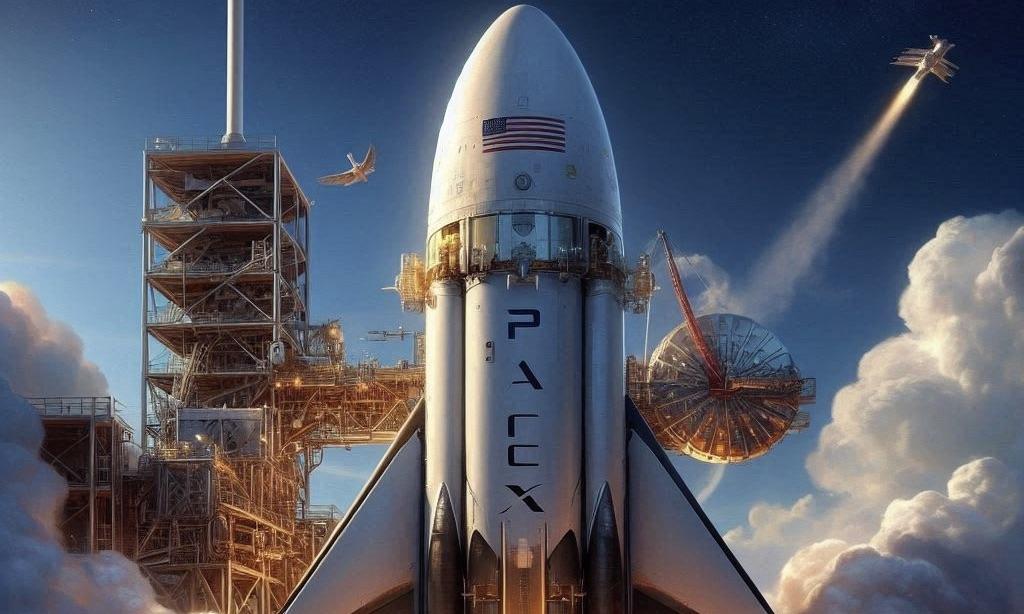SpaceX is set to relaunch its Falcon 9 rocket on Saturday (July 26) after a rare flight anomaly earlier this month. The company identified and fixed an engine issue, ensuring the rocket's safety and readiness for its next mission.
SpaceX Identifies and Fixes Falcon 9 Anomaly, Set for Saturday Relaunch
After a rare flight anomaly earlier, this month led to the loss of its second-stage Falcon 9, SpaceX is ready to fly its workhorse rocket again on Saturday, according to a fresh update from the company. In a post on X and a press release, SpaceX highlighted that the engine anomaly, which "damaged the engine hardware," was due to a faulty sense line for the second-stage engine's liquid oxygen supply. SpaceX will remove this hardware from the second stage as part of remediation since it is unnecessary for the Falcon 9's safety profile. It has also "proactively replaced" some hardware in "select locations" in its active booster fleet.
According to SpaceX, the Falcon 9 second stage developed a liquid oxygen leak due to "a crack in a sense line for a pressure sensor," which cracked because of "fatigue caused by high loading from engine vibration" due to a loose clamp that typically holds the line in place. These lines, called impulse lines, protect sensors from extreme temperatures and vibrations in a system.
The liquid oxygen leak excessively cooled the second stage's Merlin engine's hardware. Within the hardware system, components responsible for pumping injection fluid to the engine were also affected, leading to a "hard start" for the engine, according to the firm. Hard starts generate excessive force, which damages the engine hardware and leads to the second stage, where the engine cannot control its orientation in space.
SpaceX to Relaunch Falcon 9 on Saturday After Thorough Inspection and FAA Approval
Following its investigation, SpaceX plans to conduct its next launch of the Falcon 9 on Saturday (July 26). Before the earlier release, there were hints that it was ready to return to flight as SpaceX static fired a Falcon 9, Wccftech reported.
As part of the rectifications following the anomaly, SpaceX will remove the "failed sense line and sensor on the second stage engine." The company has tested the design change at its facilities in McGregor, Texas, with the Federal Aviation Administration (FAA) also involved during the qualification analysis. SpaceX added that it evaluated its active booster fleet for similar anomalies and checked the rockets' sense lines and clamps. It shared that this review and inspection resulted in a "proactive replacement in select locations.”
Based on these inspections and SpaceX's report to the FAA, the firm believes it can return to flight on Saturday. An update from the FAA states that the "Falcon 9 vehicle can return to flight operations while the overall investigation remains open."
SpaceX's Falcon 9 has become America's and the industry's workhorse due to its rapid cadence fueled by booster reuse. Despite the second-stage failure, the first-stage booster has not malfunctioned during flight in years. This rocket is responsible for launching SpaceX's Starlink satellites and astronauts for NASA to the International Space Station (ISS) and national security launches for the Pentagon and other agencies.



 BTIG Initiates Buy on SoftBank as AI and Robotics Strategy Gains Momentum
BTIG Initiates Buy on SoftBank as AI and Robotics Strategy Gains Momentum  China’s AI Sector Pushes to Close U.S. Tech Gap Amid Chipmaking Challenges
China’s AI Sector Pushes to Close U.S. Tech Gap Amid Chipmaking Challenges  FDA Limits Regulation of Wearable Devices and Wellness Software, Boosting Health Tech Industry
FDA Limits Regulation of Wearable Devices and Wellness Software, Boosting Health Tech Industry  Ancient Mars may have had a carbon cycle − a new study suggests the red planet may have once been warmer, wetter and more favorable for life
Ancient Mars may have had a carbon cycle − a new study suggests the red planet may have once been warmer, wetter and more favorable for life  xAI Cash Burn Highlights the High Cost of Competing in Generative AI
xAI Cash Burn Highlights the High Cost of Competing in Generative AI  SMIC Shares Climb as China Boosts Chipmaking Support Amid AI Optimism
SMIC Shares Climb as China Boosts Chipmaking Support Amid AI Optimism  Lost in space: MethaneSat failed just as NZ was to take over mission control – here’s what we need to know now
Lost in space: MethaneSat failed just as NZ was to take over mission control – here’s what we need to know now  Trump and Merck KGaA Partner to Slash IVF Drug Costs and Expand Fertility Coverage
Trump and Merck KGaA Partner to Slash IVF Drug Costs and Expand Fertility Coverage  Eli Lilly’s Inluriyo Gains FDA Approval for Advanced Breast Cancer Treatment
Eli Lilly’s Inluriyo Gains FDA Approval for Advanced Breast Cancer Treatment  SpaceX’s Starship Completes 11th Test Flight, Paving Way for Moon and Mars Missions
SpaceX’s Starship Completes 11th Test Flight, Paving Way for Moon and Mars Missions  Anthropic Launches HIPAA-Compliant Healthcare Tools for Claude AI Amid Growing Competition
Anthropic Launches HIPAA-Compliant Healthcare Tools for Claude AI Amid Growing Competition  China Reviews Meta’s $2 Billion AI Deal With Manus Amid Technology Control Concerns
China Reviews Meta’s $2 Billion AI Deal With Manus Amid Technology Control Concerns  FCC Exempts Select Foreign-Made Drones From U.S. Import Ban Until 2026
FCC Exempts Select Foreign-Made Drones From U.S. Import Ban Until 2026  EU Orders Elon Musk’s X to Preserve Grok AI Data Amid Probe Into Illegal Content
EU Orders Elon Musk’s X to Preserve Grok AI Data Amid Probe Into Illegal Content  Discord Confidentially Files for U.S. IPO, Signaling Major Milestone
Discord Confidentially Files for U.S. IPO, Signaling Major Milestone  NASA and Roscosmos Chiefs Meet in Florida to Discuss Moon and ISS Cooperation
NASA and Roscosmos Chiefs Meet in Florida to Discuss Moon and ISS Cooperation 































